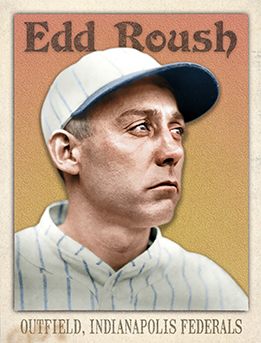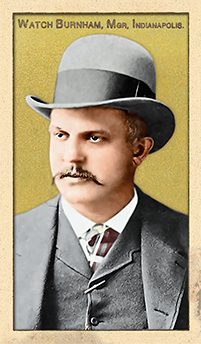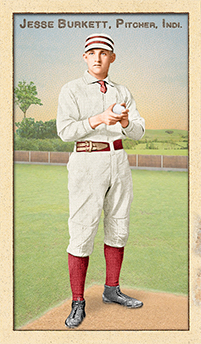
- Series: Diamond Heads '15
- City: Indianapolis
- Team: Hoosiers (FL)
- League: Federal League
- Hall: National Baseball Hall of Fame
Edd J. Roush (1893-1988) was an Indiana farm boy who knew his own mind. He built a Hall of Fame career on doing things his way. Spring training? Not for Edd, he stayed in shape. Use a bat heavier than any other player? Why not? His farm-bred arm strength allowed him to hit the ball wherever he chose with the weight of the bat doing most of the work. Stand still in the box awaiting the pitch? Not for Edd. He'd move his feet after the ball left the pitcher's hand, positioning himself according to his read. Endure management's miserly ways? No, Edd would hold out every year for a fairer contract. He'd skip to pirate leagues (the Federals) if necessary to find a better salary, something he had done as a school-boy player in Hoosier country and continued throughout his long and storied major league tenure. It took a few years in the bigs and a curious impatience by renowned manager John McGraw to get Edd to Cincinnati and the stage on which he would set records. Twice he edged out Rogers Hornsby for batting titles. He led the Reds to the Series championship in 1919, only to have that accomplishment tarnished by scandal. There is little doubt he was right in asserting that his club was better than Chicago's and really won it fair and square. During his twelve years with the Reds, Roush's batting average was .331. He never struck out more than 25 times in a season. He was fast on the bases and a terror in center, regarded as perhaps the premier defender of the Dead Ball era with Tris Speaker the competition.
- McGraw sent young Edd from the Giants to Cincy in 1916 along with two other future Hall-of-Famers: Bill McKechnie and Christy Mathewson. Matty was tickled to get a manager position and Edd and Bill were thrilled to get out from under the tough taskmaster McGraw
- When Edd threw out the ball at the last game played at Crosley Field, Joe Morgan said Roush was “the best of us all.”
- Elected to Hall of Fame: 1962
- Series: 1880s: Loving Paupers
- City: Indianapolis
- Team: Hoosiers (NL)
- League: National League
Leven Lawrence Shreve (1869-1942) had a spotty experience in the major leagues beginning with the Baltimore Orioles in 1887, moving to the Indianapolis Hoosiers that year and staying there until 1889. His total pitching record was 1-1 with a 5.40 ERA. Shreve was a slight 150 lb right-hander. He had played for two minor-league clubs in ‘86: Savannah and Chattanooga in the Southern Association where he was a combined 12-9. He was said to have played for some midwestern teams that year but no data survives, so he may not have made the squads. Following the Hoosiers, Lev did get to play briefly in the Twin Cities and ended his stint in pro ball with the Rochester Hop Bitters of the Eastern Association in 1891.
- Shreve mustered only four hits with the Orioles, but got three of them during his debut. Despite being shelled, his bat helped him win 15-9
Auction History
Cartophilia
Old Judge Pose: 418-5

- Series: Jim Dandie Feds
- City: Indianapolis
- Team: Hoosiers (FL)
- League: Federal League
James Joseph Esmond (1889-1948) played shortstop for three major league clubs from 1911-1915, half of his tenure being with two Federal League teams: the Indianapolis Hoosiers and Newark Pepper. Jimmy had started in pro ball with the Gloversville-Johnstown/Elmira nine of the New York State League in 1908, a team with constituents all over the upstate area that would be reconstituted from 1939-51 in the Canadian-American League. Esmond never managed much offensive output in the minors and may have been that rare player to perform better when he got to the Cincinnati Reds in 1911 and hit .273. He reverted to form in '12, taking a demotion to the International League's Montreal team in 1913 before getting a final chance at major league glory in the renegade Federal League. He would be out of baseball for all of his late twenties before reappearing with Syracuse of the IL in 1921 at age 31. He then moved to the Eastern League and played a season each for Waterbury, Albany and Pittsfield. Jimmy's performance in Indiana and New Jersey far exceeded his norm, undoubtedly due to the paucity of truly major league caliber talent as the Feds tried valiantly to compete as a third league. He hit .295 for the Hoosiers with a league-leading 15 triples. Though his batting average subsided with the Peps he hit 11 more three-baggers showing extra-base prowess heretofore not in evidence. Esmond's debut in Newark allowed him to bask in the glow described in the local paper: “Newark and its surrounding hamlets were seized with a violent attack of baseball yesterday, accompanied by a high fever and laryngitis. The ailment can be directly traced to the opening of the Newark Federals at their new, roomy park in Harrison. The epidemic spread among nearly 25,000 Jersey folk who jammed the new park to see 'Whoa Bill' Phillip's 'Peps' make their home debut against Otto Knabe's Baltimore Terrapins.” The celebration was dampened a bit by the Terps' 6-2 victory. Sadly, Jimmy's three errors made it tough for starter Cy Falkenberg.
- Esmond's major league debut in Cincinnati was in the ballpark known as the Palace of the Fans, occupied by the franchise since 1902. In 1912 Jimmy and the Reds got to inaugurate Crosley Field, the team's home until 1970
- Series: Beginnings: 1880's
- City: Indianapolis
- Team: Hoosiers (NL)
- League: National League
- Hall: National Baseball Hall of Fame
Jesse “the Crab” Burkett (1868-1953) was a Hall of Fame outfielder from 1890 to 1905. Following Ed Delahanty, Burkett became the second major leaguer to hit .400 twice (‘95 &’96 for the Cleveland Spiders.) Led the NL with .376 in 1901 while with the St Louis Cardinals.
- Still holds MLB record for inside-the-park HRs with 55
- First West Virginian elected to Hall of Fame
- Elected to Hall of Fame: 1946
- Jesse Burkett did not appear in the Old Judge series. This image is taken from a photo that appeared in The Sporting Times in February, 1890. Signed by Indianapolis as a young pitching phenom after the close of the 1889 season, Burkett would never pitch for the Hoosiers as the franchise folded before the 1890 season. Burkett then made his major league debut with the New York Giants in 1890 on a pitching staff that included Amos Rusie and Mickey Welch.

- Series: Beginnings: 1880's
- City: Indianapolis
- Team: Hoosiers (NL)
- League: National League
George Walter Burnham (1860-1902) was lured from the ranks of National League umpires to become the first manager of the new Indianapolis Hoosiers franchise when John Brush brought the beleaguered St Louis Maroons to a joyous community. “Watch” thus became a key figure in the sad saga of major league baseball in Indiana. The club lost every one of its arduous 22-game road trip and floundered all of the 1887 inaugural year. Burnham thought fining all the players might improve morale but captain Jack Glasscock mutinied. The Chicago Tribune reported the fear that “someday the men will decline to go on the field.” Days later Brush replaced Watch with another manager with no playing or managing experience and would try yet another neophyte, a sportswriter, before that dismal season mercifully ended with a 37-89 record. Burnham’s reputation preceded him to the Hoosiers and gave pause. The nickname was said to have derived from George’s failed attempt at self-promotion by presenting himself with an engraved watch during a Cleveland game in ‘83 that he was umpiring.
- Watch’s total experience officiating was 107 games scattered over five seasons between ‘83 and ‘95. He called Old Hoss Radbourn’s no-hitter on July 25, 1883
- The Hoosiers’ prospect finally seemed ready to improve in 1889 with the arrival of Amos Rusie. Sadly for the city, Brush parlayed his investment into a lucrative career with the Reds and Giants by dumping the woebegone Hoosiers after their third losing season




